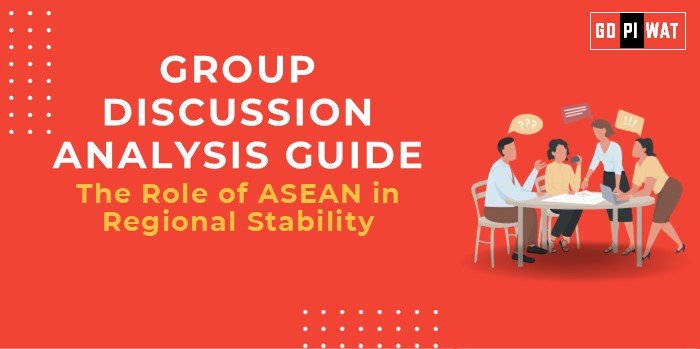📋 Group Discussion Analysis Guide: The Role of ASEAN in Regional Stability
🌐 Introduction to the Topic
Opening Context: Regional organizations like ASEAN have become key players in fostering peace and stability, especially in areas prone to geopolitical tension. With ASEAN’s focus on regional cooperation, its role is vital in maintaining a rules-based international order.
Topic Background: Established in 1967, ASEAN aims to accelerate economic growth, promote social progress, and maintain regional peace. Over the decades, ASEAN’s mechanisms like the ASEAN Regional Forum (ARF) and the Treaty of Amity and Cooperation have provided platforms for dialogue and dispute resolution.
📊 Quick Facts and Key Statistics
👥 Population: Over 660 million (2024), representing one of the most diverse regions globally.
💰 Economic Significance: Combined GDP of $3.9 trillion in 2024.
🕊️ Conflict Resolution: Facilitated peace agreements in Cambodia (1991) and the Mindanao conflict in the Philippines (2014).
📈 Global Trade Contribution: ASEAN accounts for 7% of global trade, emphasizing its economic diplomacy’s role in stability.
🤝 Stakeholders and Their Roles
- 🏛️ Member States: Contribute to collective decision-making on security and economic cooperation.
- 🌏 Dialogue Partners: (e.g., USA, China, Japan): Provide diplomatic support and economic investment while engaging in regional stability dialogues.
- 📢 International Organizations: (UN, WTO): Collaborate on initiatives like disaster response and trade facilitation.
- 👥 Civil Society: Advocates for inclusive policies and addresses social challenges like human trafficking.
🏆 Achievements and Challenges
✨ Achievements:
- 🤝 Peace Promotion: The ASEAN Regional Forum has successfully reduced tensions in the South China Sea.
- 📜 Economic Stability: Initiatives like the ASEAN Free Trade Area (AFTA) have fostered economic interdependence.
- 🌊 Crisis Response: Efficient coordination during natural disasters (e.g., 2004 tsunami recovery efforts).
- ⚖️ Human Rights Advocacy: Formation of the ASEAN Intergovernmental Commission on Human Rights.
⚠️ Challenges:
- 🛑 Lack of Enforcement Mechanisms: For conflict resolution.
- 📉 Varying Levels of Development: Among member states.
- 🌐 External Pressures: From powers like the USA and China.
- ⚠️ Regional Issues: Such as the Rohingya crisis.
📚 Global Comparisons:
- ✅ Success: The European Union’s integration model serves as inspiration.
- ❌ Challenges: African Union’s struggle with political instability highlights common issues.
📚 Case Studies:
- 🌏 Resolution: The 2000 Thai-Cambodian border dispute.
🗣️ Structured Arguments for Discussion
Supporting Stance: “ASEAN’s non-interference policy ensures regional harmony by respecting national sovereignty.”
Opposing Stance: “ASEAN’s lack of punitive measures undermines its ability to enforce decisions.”
Balanced Perspective: “While ASEAN promotes dialogue, its impact is limited by geopolitical constraints.”
💡 Effective Discussion Approaches
- 📜 Opening Approaches:
- Start with ASEAN’s historical achievements (e.g., Cambodia peace accord).
- Use statistics like its GDP growth or population diversity.
- 🛠️ Counter-Argument Handling:
- Rebut with examples of economic successes reducing conflict risk.
- Use comparative analysis (e.g., EU vs. ASEAN).
📈 Strategic Analysis of Strengths and Weaknesses
- 🏅 Strengths: Economic interdependence, cultural diplomacy.
- ⚠️ Weaknesses: Enforcement challenges, resource disparities.
- 💡 Opportunities: Expanding influence via partnerships.
- ⚡ Threats: Rising nationalism, external power rivalries.
🎓 Connecting with B-School Applications
- 📚 Real-World Applications: Insights into conflict resolution and economic integration for business strategies.
- 💬 Sample Interview Questions:
- “How can ASEAN manage South China Sea tensions?”
- “What lessons can ASEAN learn from the EU?”
- 🔑 Insights for B-School Students: Applications in global strategy and crisis management.


